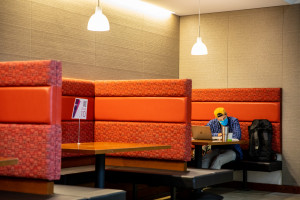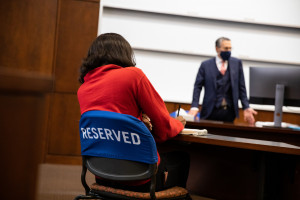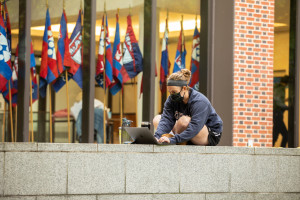University of Pennsylvania Carey Law School’s successful in-person fall semester
This past summer, after Penn announced a fall return to campus, University of Pennsylvania Carey Law School Dean Ted Ruger shared his detailed plan for the Law School’s safe resumption of in-person academic activities while also ensuring the health and safety of its community in the face of COVID-19. Now, as the semester comes to a close, the verdict is in: Despite the many obstacles and necessary changes, in-person instruction and on-campus activities for the fall semester were a resounding success.
With 551 law students – including 222 first-years – attending class in-person, there was no evidence of any spread of the novel coronavirus within Law School buildings in the fall. This is a uniquely remarkable accomplishment for the Law School, especially in light of the varied success of other educational institutions across the country.
“The only reason we were able to do all of this is because of incredible coordination across a number of departments, particularly the Facilities department, ITS, and Student Affairs,” said Eleanor Barrett L’05, Associate Dean for Curricular Affairs. “It took a lot of coordinating among those departments and with the University to make sure that we could implement safe protocols and enforce them through our building, and I think we were successful in doing that.”
A carefully coordinated effort
The plan included offering a combination of in-person and remote instruction (students could choose to participate fully remotely if they wished) as well as creating designated student spaces for remote class attendance as well as for studying, with the understanding that all students, faculty, and staff who returned to campus in any capacity were required to follow University public health and safety guidelines.
The Law School required weekly COVID-19 tests for all on-campus students, and the University also provided tests for faculty and staff. Anyone entering Law School buildings were required to complete and obtain a Green PennOpen Pass (a symptom checker survey), while Penn Card swipes limited building census to students and faculty.
 Health regulations limited class sizes to 25 people per room, including lecture halls that ordinarily fit over 100 people. The Facilities team at the Law School coordinated with an architect to map out socially distant seating in every classroom, and additional protocols included reserved seating to eliminate close student interactions, shifting office hours online or outdoors, and prohibiting any eating within the building, while also providing masks, wipes for desks, and hand sanitizer stations throughout campus.
Health regulations limited class sizes to 25 people per room, including lecture halls that ordinarily fit over 100 people. The Facilities team at the Law School coordinated with an architect to map out socially distant seating in every classroom, and additional protocols included reserved seating to eliminate close student interactions, shifting office hours online or outdoors, and prohibiting any eating within the building, while also providing masks, wipes for desks, and hand sanitizer stations throughout campus.
“It’s a true testament to our 1Ls’ commitment to learning when you see how many of them are in the Courtyard for office hours even as temperatures dropped,” said Felicia Lin L’08, the Law School’s Dean of Students. “Despite all of these new rules, we had very few compliance issues. I think the two words that really mark this semester’s student body are resilience and responsibility. Everyone did their part to keep our community as healthy as possible.”
Beyond the physical challenges of converting existing spaces into safe environments, there was the necessary, careful coordination of student schedules between in-person, remote, and hybrid structures. This was in addition to the logistics of assigning classrooms, ensuring students either had time to go home between classes or a space assigned to them in the building as needed, and the creation of additional workspace in the building. In total, 276 spaces could be reserved, including 35 private rooms as well as remote rooms for students to attend the same remote classes together in one space.
 Coordinating the curriculum structure for 1Ls was particularly challenging. The typical three doctrinal class structure, in which roughly 250 students are usually broken into three sections, was adjusted to accommodate the new regulations and reduced class sizes. 1L faculty rose to the occasion, coming together to add sections so that students were split into six sections for the fall. Smaller class sizes not only allowed students the opportunity to receive in-person instruction more often, but also helped foster a community of learning in a remote environment that would otherwise arise organically on campus.
Coordinating the curriculum structure for 1Ls was particularly challenging. The typical three doctrinal class structure, in which roughly 250 students are usually broken into three sections, was adjusted to accommodate the new regulations and reduced class sizes. 1L faculty rose to the occasion, coming together to add sections so that students were split into six sections for the fall. Smaller class sizes not only allowed students the opportunity to receive in-person instruction more often, but also helped foster a community of learning in a remote environment that would otherwise arise organically on campus.
“One of the things that makes our law school distinct is our size and the amount of individual attention and personal relationships that our students can develop with their professors and our professors’ investment in individual students,” said Barrett. “Making first-year class sizes smaller where possible was a tangible reflection of our commitment to that.”
Facing the challenge
The obvious obstacle heading into the semester was creating the best conditions for students and faculty that met current public health and safety guidelines during the pandemic. But the difficulty for faculty embarking in an unprecedented teaching environment should not be underestimated, either.
Face masks, while necessary for faculty and students at all times, created certain physical limitations. Would students spread out across a room and attending remotely be able to clearly hear professors and peers? Would some level of engagement, nonverbal cues, or general connection be lost in the process?
 “It turns out a lot of teaching is really subtle social cues, knowing ‘it’s going badly’ or ‘it’s going well,’” said Professor of Law David Hoffman. “You can’t read the room at all. I’m very Socratic. I don’t use PowerPoint; I like asking questions. So much of that turns out to be a delicate touch – am I going too far? Is this funny? Am I connoting sympathy? It feels like I had my antennae cut off.”
“It turns out a lot of teaching is really subtle social cues, knowing ‘it’s going badly’ or ‘it’s going well,’” said Professor of Law David Hoffman. “You can’t read the room at all. I’m very Socratic. I don’t use PowerPoint; I like asking questions. So much of that turns out to be a delicate touch – am I going too far? Is this funny? Am I connoting sympathy? It feels like I had my antennae cut off.”
In addition to the grueling teaching schedule, time management wrinkles, and challenging conditions, there were plenty of technical questions going into the experience as well. Which video streaming platform made the most sense to use? What kind of camera setups best captured specific instructor’s strengths and teaching styles? How do you keep students who are joining remotely engaged for a two-hour class, while also making them feel they’re a part of the same community as their in-person counterparts?
“My early fears about being unable to connect with students, to truly know them as learners and as people, were unfounded,” said Sarah Pierce, Associate Dean for Legal Practice Skills. “We structured our LPS class as we typically do, but taught half the class in the morning and half the class in the afternoon. Being in a smaller group was a wonderful change, and during class time it was easier to focus on students when there were only 25 of them in the room.”
Faculty tried multiple solutions to engage students. Hoffman, for instance, chose to focus on calling on only students who were physically present to create a more seamless experience for everyone. Heimbold Chair in International Law Eric Feldman, on the other hand, elected at times to use a multiple computer and camera setup to project the images of remote learners on screen, to create the feeling of a full classroom even if it was slightly one sided. It had mixed reviews for those on the remote end, who could be seen but in turn weren’t able to view their fellow classmates.
“I consulted with the students about it – you know I want to make this the best semester for all of us that I can and I need your feedback to do that,” said Feldman. “We have one shot at this, none of us has ever done this before. We’re incredibly fortunate to be in person, but we’re trying different things.”
 Across the board professors were thoughtful and intentional in creating an engaging educational environment. If something wasn’t working, there was constant flexibility to adapt on the fly in these new conditions with unique innovations and tweaks to the model, with plenty of support from ITS for any major technical troubleshooting.
Across the board professors were thoughtful and intentional in creating an engaging educational environment. If something wasn’t working, there was constant flexibility to adapt on the fly in these new conditions with unique innovations and tweaks to the model, with plenty of support from ITS for any major technical troubleshooting.
“I think the IT department and Law School administration has done a really remarkably good job at creating the conditions that enable us to do what we’re doing,” Feldman said. “It was such a pivot to enable this to happen. I think the IT folks just deserve a ton of credit. Neal [Swisher] and his team, Dan [Darrow] and all the folks who support us are both pleasant and competent in a way that none of us really deserve, but they’re great.”
Breakout rooms and sessions during classes were another popular feature, which gave students the opportunity to connect more intimately with one another while also easily allowing the cross-interaction between remote and in-person students to occur a bit more naturally.
Hoffman and Professor of Law and Psychology Tess Wilkinson-Ryan L’05 innovated supplemental learning materials in the form of creating a podcast in which they discuss various contracts cases. The podcast, called “Promises, Promises” aired its first episode in late July, but continued through the fall, garnering attention outside of the Law School with upwards of 15,000 listeners.
“I think the students really liked it because it’s a different way to get information,” Hoffman said. “You can take the class on a walk, and I think especially for people who were tired of doing Zoom, but want to hear interesting discussions, I think it was great. And from what I’ve heard that particular podcast has been assigned in other law school classrooms all over the country.”
It’s easy to question whether all of this time and effort is actually worth it in the middle of a pandemic, especially when its success depends entirely on the cooperation of everyone involved, which in turn could break down if not for that supreme effort and shared responsibility.
“I would do it again,” Hoffman said. “No question whether I would do it again. No question I feel so proud of Penn for giving this everything it had, which was lot of resources, and a lot of people time.”
The feedback from faculty and students has been extraordinarily positive, despite the many challenges and potential setbacks present throughout the year, making the answer to that question of worth a resounding yes. These circumstances created unique learning opportunities, new innovations, and a shared sense of experience.
“I truly felt at the end of the semester that I got to know my students and their work as well as I have in any other semester,” said Pierce. “And perhaps more so, given our unique circumstances and need for connection to each other and our shared work and goals during these isolating times.”
“Resilience and responsibility”
3L Lauren Altus L’21 said she was grateful for the concentrated effort of Law School faculty and administration in not only keeping students safe but ensuring their educational experience would not be diminished. In particular, the draw and importance of being on campus in creating that experience should not be diminished either.
 “When planning for the fall semester, my biggest priority was ensuring I would be able to have some in-person classes,” said Altus. “There is something about being on the Penn campus and in the Law School that cannot be replicated. I am very grateful to be able to continue that experience into my 3L despite the extreme circumstances.”
“When planning for the fall semester, my biggest priority was ensuring I would be able to have some in-person classes,” said Altus. “There is something about being on the Penn campus and in the Law School that cannot be replicated. I am very grateful to be able to continue that experience into my 3L despite the extreme circumstances.”
Such a coordinated effort across so many departments and individuals can really only go as far as its intended purpose – which is serving Law School students in the utmost capacity. And that went beyond just those who elected to be in-person.
Remote learning financial assistance from the Law School enabled students to improve their home learning situations, ranging from better furniture and lighting to increased internet speed and access for students living in areas without broadband.
Additionally, externships have been very popular among students this semester, and the remote model has produced important working experience for those students.
In the end attending law school during an unprecedented time in history is a transformative experience in its own right.
“We built a lot of resilience this semester, perhaps too much,” said Pierce. “But I hope that resilience is there for our students to rely on in the future when things are hard — in practice and in life. Their strength was evident in their daily 1L life —prepared, hardworking, and dedicated despite all the uncertainty of the world. Watching the students support each other, work incredibly hard in very difficult circumstances, focus on their wellbeing and that of their friends and loved ones, and maintain their humor and grace through it all has made all of the effort for an in-person semester more than worth it.”





